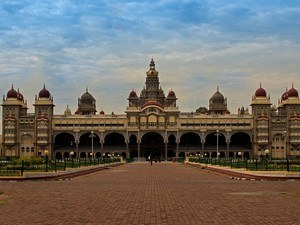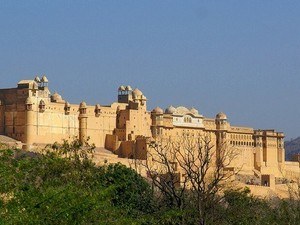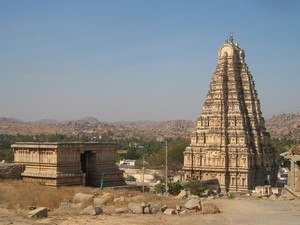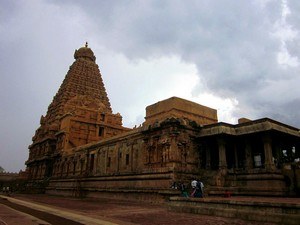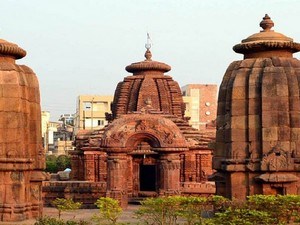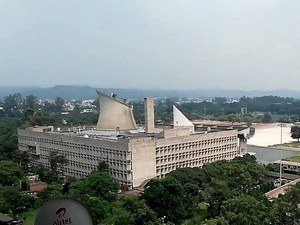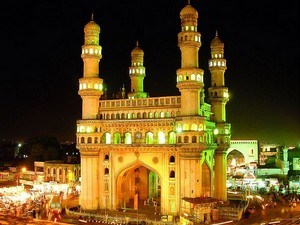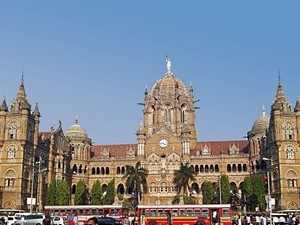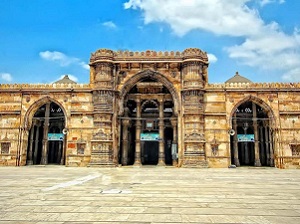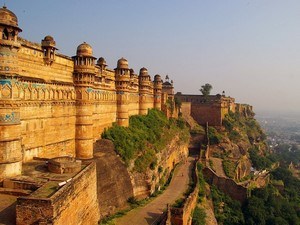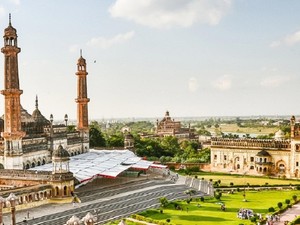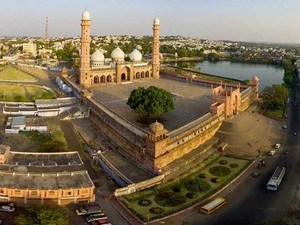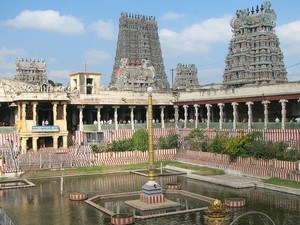1
DAY 1 : TRAVEL TO AGRA & SIGHTSEEING
DAY 1 : TRAVEL TO AGRA & SIGHTSEEING
 Sightseeing
Sightseeing
Leisure / No Sightseeing
At a distance of 6 km from Agra Cantonment Railway Station, Taj Mahal, one of the most popular tourist destinations in the world, is located on the southern bank of the Yamuna River in Agra of Uttar Pradesh State. Taj Mahal was declared as a World Heritage Site by UNESCO in 1983 and it is also counted among the seven wonders of the modern world. It attracts around four million visitors annually. Taj Mahal is the face of Agra Tourism and among the must include place in your Golden Triangle tour packages.
Taj Mahal was commissioned in 1632 by the Mughal emperor Shah Jahan (reigned 1628-1658), in the memory of his favorite wife Mumtaz Mahal. The construction of the monument was completed in 1653. The Taj Mahal was constructed under the supervision of architects Abdul-Karim Ma'mur Khan, Makramat Khan and Ustad Ahmad Lahauri. It took 21 years for the Taj Mahal to be constructed .....
 Duration of visit: 2 Hours
Duration of visit: 2 Hours
 Timings: 6 AM to 6.30 PM. Closed on Friday
Timings: 6 AM to 6.30 PM. Closed on Friday
At a distance of 6 km from Agra Cantonment Railway Station, Taj Museum is one of the most popular museums in Agra and is located in the ground floor of western Naubat Khana, also known as Jal Mahal, with in the Taj Mahal complex.
The museum was established in 1982. It is a double storied building having a quadrangle projection outside and is built on a raised platform. It is a big museum comprising of two floors and has three galleries along with a chief hall. The museum displays various exhibits relating mostly to the construction of the Taj Mahal and to the period of its builders. Totally 121 antiquities are on display, which are broadly categorized as Mughal miniature paintings, manuscripts, government decrees, specimen of calligraphy, arms, utensils, plans and drawings of Taj Complex, paintings, specimen inlay work, marble pillars, etc.
In main hall the paintings of Shah Jahan and his favourite wife Mumtaz Mahal both on ivory, encased in ornamental wooden frame, replicas .....
 Duration of visit: 30 Mins
Duration of visit: 30 Mins
 Timings: 10 AM to 5 PM. Closed on Friday
Timings: 10 AM to 5 PM. Closed on Friday
At a distance of 4.5 km from Agra Cantonment Railway Station and 2.5 Km from Taj Mahal, The Agra Fort, also known as the Lal Qila or Red Fort, is situated on the banks of Yamuna River in Agra, It is among the prime places to visit in Agra City. Uttar Pradesh. The Fort is a UNESCO World Heritage and one of the best forts in India.
Agra Fort was originally a brick fort known as Badalgarh, held by Raja Badal Singh, a Hindu Rajput king (1475 AD). Sikandar Lodi was the first Sultan of Delhi to shift his capital from Delhi to Agra. After Sikandar Lodi died in 1517, his son Ibrahim Lodi held the fort for 9 years until he was defeated and killed in the battle of Panipat in 1526. Several palaces, wells and a mosque were built in the fort during the Lodi period.
After the First Battle of Panipat in 1526, the victorious Babur stayed in the fort, in the palace .....
 Duration of visit: 1 Hour
Duration of visit: 1 Hour
 Timings: 6 AM to 6 PM
Timings: 6 AM to 6 PM
 Overnight Stay in Agra
Overnight Stay in Agra
2
DAY 2 : TRAVEL TO FATEHPUR SIKRI & SIGHTSEEING
%%Itinerary_Title_Day2%%
 Sightseeing
Sightseeing
At a distance of 1 km from Fatehpur Sikri Railway Station, Buland Darwaza or the Gate of Magnificence serves as the main entrance to the Jama Masjid Complex Fort in Fatehpur Sikri of Uttar Pradesh. This massive gate is the highest gateway in the world and it was built in 1576 AD by Akbar to commemorate his victory over Gujarat.
Buland Darwaza is an astounding example of the Mughal architecture. It is made of red and buff sandstone, decorated by white and black marble. One needs to climb a flight of 42 steps in order to reach the gateway, which stands tall at a height of 40 m. The total height of the structure is about 54 m (176 feet) from the ground level. It is a15 storied high gateway acting as the southern entrance of the city of Fatehpur Sikri. It took nearly 12 years to build this magnificent gateway.
It is semi octagonal in plan and two smaller triple storeyed wings on either side. It has three kiosks on its top surrounded by thirteen smaller domed kiosks. There are .....
 Duration of visit: 15 Mins
Duration of visit: 15 Mins
 Timings: 7 AM to 6 PM. Closed on Friday
Timings: 7 AM to 6 PM. Closed on Friday
At a distance of 1 km from Fatehpur Sikri Railway Station, Jama Masjid or Jami Masjid is one of the largest mosques in India and situated on the highest point of the ridge in Fatehpur Sikri Complex. This is one of the most notable tourist attractions to visit in Fatehpur Sikri as part of Agra tour. This mosque was recognized as a World Heritage Site by UNESCO in 1986.
The Jami Masjid was built by Akbar in 1571-72 AD. This is also called Friday mosque. It is the congregational mosque and was perhaps one of the first buildings to be constructed in the complex. It was built under the supervision of Sufi Saint, Sheikh Salim Chishti and his descendants.
The structure of the Jama Masjid is in a rectangular form and is placed on an elevated platform. The mosque has a large courtyard and has gateway entrance from North, South and East. There are series of square shaped chhatris topped by beautiful brackets situated on the other three .....
 Duration of visit: 30 Mins
Duration of visit: 30 Mins
 Timings: 6 AM to 6 PM. Closed on Friday
Timings: 6 AM to 6 PM. Closed on Friday
At a distance of 1 km from Fatehpur Sikri Railway Station, Jodha Bai's Palace (or Jodha Bai Ka Rauza) is one of the largest buildings in the complex of Fatehpur Sikri. This Palace was constructed by Akbar for his favorite wife, Jodha Bai who was a Rajput Princess.
According to history, after Akbar conquered Malwa he faced strong resistances from the Rajput kings. Akbar dealt with the problem diplomatically, allowing them to keep their kingdoms and getting into marriage alliances with the princess of the Rajput clan. He married Jodha Bai, sister of Man Singh, the powerful ruler of Jaipur. She was his favorite queen and allowed to worship Hindu deity in her palace.
Jodha Bai Ka Rauza is an excellent example of the fusion of Hindu and Muslim architectures. The palace has distinct Gujarati and Rajasthani architectural patterns. The palace building consists of a rectangular block with a single magnificent gateway on eastern side, which .....
 Duration of visit: 15 Mins
Duration of visit: 15 Mins
 Timings: 7 AM to 6 PM. Closed on Friday
Timings: 7 AM to 6 PM. Closed on Friday
At a distance of 1 km from Fatehpur Sikri Railway Station, Panch Mahal is five-storey architectural monument located on the northeast direction of Jodha Bai's palace inside the Fatehpur Sikri Fort Complex of Uttar Pradesh.
Panch Mahal was built by Emperor Akbar primarily used as a recreational and pleasure palace by the queens and the other ladies of the court. This is also known as badgir or the wind tower. This pillared pavilion is made of red sand stone comprising of five pavilions, each of which is connected to the next floor by a flight of stairs. The ground floor of the building is made up of 84 pillars that supports the entire structure. As one climbs up the Panch Mahal, the size of the pavilions becomes smaller and the number of pillars supporting the upper floor decreases in number. The first floor has 56 pillars, 20 pillars on second floor, 12 on the third floor and 4 on the fourth level.
The top floor consists of a single dome with floral motifs on top. All the .....
 Duration of visit: 15 Mins
Duration of visit: 15 Mins
 Timings: 7 AM to 6 PM. Closed on Friday
Timings: 7 AM to 6 PM. Closed on Friday
At a distance of 1 km from Fatehpur Sikri Railway Station, Hiran Minar is located close to Caravanserai in Fatehpur Sikri Fort. It is believed that Akbar built Hiran Tower in the memory of his favorite elephant, Hiran. Alternatively, it is also believed that this tower served as a mile post and a light house for the night travelers.
With a height of 21.34 m, Hiran Minar is octagonal at the ground level and circular to the rest of the tower. This is built over an octagonal platform, which in turn stands on a square base. This tower is decorated with an alternate row of hexagons and six point stars. Earlier, elephant tusks were placed emerging from the center of each star, which are now replaced with stone tusks.
The tower is entered through a flat-topped door bordered by sand stone panel and flanked by closed arched panels. There are 53 steps leading to the top inside the tower. One can get a bird's eye view of Fatehpur Sikri from the top of the tower. It is believed that this .....
 Duration of visit: 15 Mins
Duration of visit: 15 Mins
 Timings: 7 AM to 6 PM. Closed on Friday
Timings: 7 AM to 6 PM. Closed on Friday
At a distance of 1.5 km from Fatehpur Sikri Railway Station, Archaeological Museum is situated about 100 m from Diwan-i-Am in Fatehpur Sikri Fort. The structure housing the Archaeological Museum is known as Treasury Building, a centrally protected monument. It was built during Akbar's period. It was in a dilapidated condition and Archaeological Survey of India restored it extensively during 2002-04.
The Museum showcases both pre-Mughal and Mughal artifacts excavated at Fatehpur Sikri. There are four galleries in the Museum. First Gallery displays the objects including micro lithic stone tools of pre-historic period collected during surface exploration from Rasulpur and Patsal near Fatehpur Sikri, Ochre Coloured Pottery, Painted and plain grey ware pot shreds, associated Black and Red ware shreds of Painted Grey Ware culture of early Iron Age, Kushana period from excavation near Hada Mahal and Red ware pottery of different shapes from excavation at Bir Chhabili Tila.
Jain sculptures .....
 Duration of visit: 30 Mins
Duration of visit: 30 Mins
 Timings: 9 AM to 5 PM. Closed on Friday
Timings: 9 AM to 5 PM. Closed on Friday
 Overnight Stay in Agra
Overnight Stay in Agra
3
DAY 3 : VISIT MATHURA - VRINDAVAN & TRAVEL TO DELHI
%%Itinerary_Title_Day2%%
 Sightseeing
Sightseeing
At a distance of 2 km from Vrindavan Railway Station, ISKCON Temple, also known as Sri Krishna-Balaram Mandir, is a popular temple situated in Raman Reti, Vrindavan. This is one of the main ISKCON temples in India. The ISKCON Temple was built in the year 1975 and inaugurated on the auspicious occasion of Ram Navami. The foundation of the temple was laid by Swami Prabhupada, the founder of ISKCON. It was the first temple to be constructed by International Society for Krishna Consciousness (ISKCON).
The beautiful white marbled ISKCON temple has three sanctums. The presiding deity of the temple is of Lord Krishna-Balaram, which is housed under the central shrine of the temple. On the right side are Radha Krishna with Lalita and Vishakha. On the left side is a Murti of Chaitanya Mahaprabhu with Nityananda, and Swami Prabhupada and his spiritual teacher Bhakti Siddhanta Sarasvati Thakura. Krishna - Balaram Mandir enforces one of the highest standards of cleanliness and of deity worship. .....
 Duration of visit: 1 Hour
Duration of visit: 1 Hour
 Timings: 7 AM - 12 PM & 4 PM - 8.30 PM
Timings: 7 AM - 12 PM & 4 PM - 8.30 PM
At a distance of 1 km from Vrindavan Railway Station, Sri Bankey Bihari Mandir is one of the popular Vrindavan temples situated near Radhavallabh Temple in the holy city of Vrindavan. This temple is among the 7 temples of Thakur of Vrindavan including Sri Radhavallabh ji, Sri Govind Dev ji and four others.
The presiding deity of the temple is Lord Krishna. The deity was originally worshipped by Haridas Swami under the name of Kunji-bihari at Nidhivan. The idol of is much older and was worshipped in Nidhivan till 1863. The current temple was built in 1864 by Swami Haridas of the Nimbarka Sampradaya. Later, the deity of Radha Rani was added to the temple. The Bankey Bihari temple is amongst the holiest and famous temples of Lord Krishna.
The presiding deity in the temple is of Lord Krishna standing in the Tribhanga posture. The deity is worshiped and looked after as a child. The idol is black in color and is beautifully carved. Unlike other temples, the curtains before the deity .....
 Duration of visit: 1 Hour
Duration of visit: 1 Hour
 Timings: 7.45 AM - 12 PM & 5.30 PM - 9.30 PM in summer, 8.45 AM - 1 PM & 4.30 PM - 8.30 PM in winter
Timings: 7.45 AM - 12 PM & 5.30 PM - 9.30 PM in summer, 8.45 AM - 1 PM & 4.30 PM - 8.30 PM in winter
At a distance of 1 km from Vrindavan Railway Station, Govind Deo, which is also known as Govind Dev Temple, is one of the most important holy places in Vrindavan.
The Govind Dev Temple was built by Raja Man Singh, the ruler of Amber, Rajasthan in 1590 at a cost of ten million rupees. It is an astonishingly beautiful seven storey temple dedicated to Govind Dev, another name for Lord Krishna. The temple was partially destroyed by Mughal ruler Aurangzeb in 1670, and now only a three storied structure remains.
The architecture of the temple is different from those of conventional temples. This temple reflects the architectural elements of Western, Hindu and Muslim style. The temple was designed in the form of Greek cross and was made using red sandstone. The temple has an imposing facade, looking like a European cathedral because of the pillars and colonnades. It is built on a raised platform and one has to climb a flight of stairs to reach the main hall. The temple has an impressive .....
 Duration of visit: 30 Mins - 1 Hr
Duration of visit: 30 Mins - 1 Hr
 Timings: 8 AM - 12.30 PM & 4.30 PM - 8 PM
Timings: 8 AM - 12.30 PM & 4.30 PM - 8 PM
At a distance of 4 km from Mathura Junction Railway Station, Dwarkadheesh Temple is one of the oldest and largest temples in Mathura. It is located near the banks of river Yamuna, close to Vishram Ghat and Gatashram Tila. It is one of the top places to visit in Mathura and also one of the most visited Mathura temples.
The main deity of the temple is Lord Dwarkadheesh, a form of Lord Krishna. This temple is also famous by other names like Jagat Mandir or Nija Mandir. It is believed that this temple was built by Lord Krishna's grandson Vajranabha. The present temple was built by Seth Gokuldas Parikh, the treasurer of Gwalior State in 1814. He was a great devotee of Lord Krishna and erected the shrine to commemorate the deity.
The temple is known for its beautiful architecture, carvings, and paintings. This five storied building is supported by seventy two pillars. The main shrine has the images of Lord Krishna and his beloved .....
 Duration of visit: 30 Mins - 1 Hr
Duration of visit: 30 Mins - 1 Hr
 Timings: 7 AM - 1 PM & 5 PM - 9.30 PM
Timings: 7 AM - 1 PM & 5 PM - 9.30 PM
At a distance of 4.5 km from Mathura Junction Railway Station, Vishram Ghat is a sacred bathing ghat situated on the banks of river Yamuna in Mathura.
Vishram Ghat is the main ghat of Mathura and is central to 25 other ghats. The ghat is made up of marble stone and has a large stone arch. According to the legend, Lord Krishna is said to have rested at this place after killing Kansa. The name of the ghat is derived from this particular incidence (Vishram means Rest). The Vishram Ghat is one of the most important ghats as the traditional parikrama starts and ends at this place. The parikrama is the circumambulation of all the major religious and cultural places of Mathura.
The Vishram ghat is lined with elegant temples and some of Mathura's most important shrines that include Mukut Temple, Radha-Damodar, Murali Manohar, Neelkantheshwar, Yamuna-Krishna, Langali Hanuman and Narasimha temples.
During the evening, aarti .....
 Duration of visit: 30 Mins
Duration of visit: 30 Mins
 Timings: Aarti: 7 PM - 7.15 PM in summer & 6.45 PM - 7 PM in winter
Timings: Aarti: 7 PM - 7.15 PM in summer & 6.45 PM - 7 PM in winter
At a distance of 4 km from Mathura Junction Railway Station, Sri Krishna Janmabhoomi is the most famous temple located in the crowded city of Mathura. The temple is the most important site for the followers of Lord Krishna and Hindus as a whole.
Sri Krishna Janma Bhoomi also known as Katra Keshav Dev temple, is the actual birthplace of Lord Krishna. A bigger temple was constructed to replace the old temple during the reign of Emperor Chandragupta Vikramaditya (4th century CE). This temple used to one of the grandest temples in India until it was destroyed by Ghazni Mahmud in 11th century. In 1150 AD, Jajja during the rule of Vijay Pal Deva rebuilt the temple but the temple was destructed by other Muslim ruler Sikandar Lodi in 16th century. The fourth temple was built during the rule of Mughal emperor Jahangir by Veer Singh Bundela of Orchaa. But it was again destroyed by Aurangzeb in 1669 AD and a mosque named Jami Masjid was built .....
 Duration of visit: 1 Hour
Duration of visit: 1 Hour
 Timings: 5 AM - 12 PM & 3 PM - 8.30 PM
Timings: 5 AM - 12 PM & 3 PM - 8.30 PM

